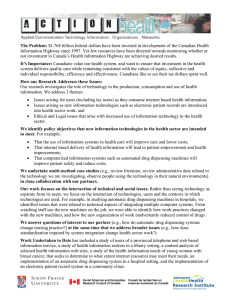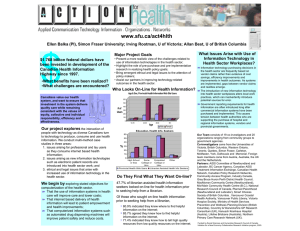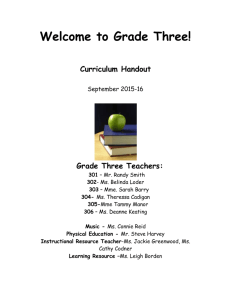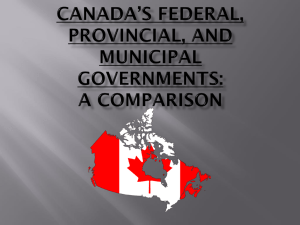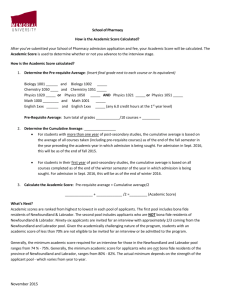ROYAL COMMISSION ON RENEWING AND STRENGTHENING OUR PLACE IN CANADA
advertisement
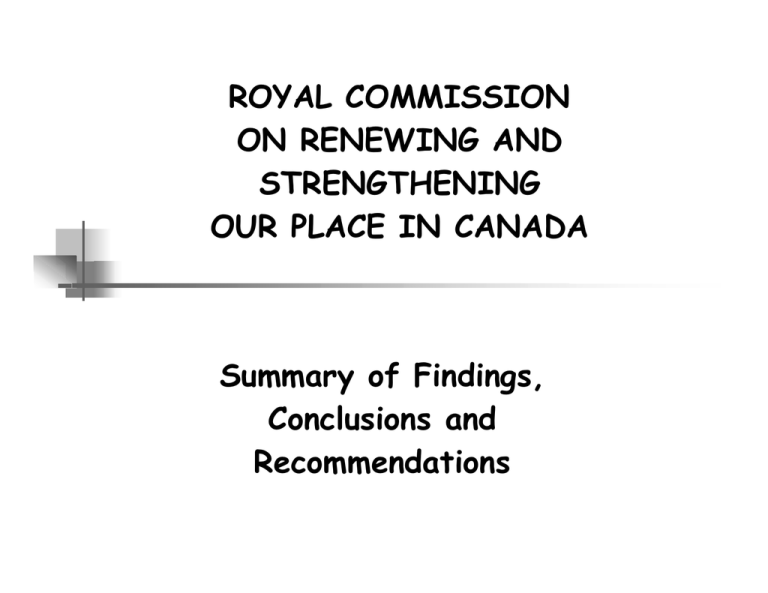
ROYAL COMMISSION ON RENEWING AND STRENGTHENING OUR PLACE IN CANADA Summary of Findings, Conclusions and Recommendations COMMISSION’S MANDATE Undertake a critical analysis of our strengths and weaknesses Make recommendations as to how best achieve prosperity and selfreliance TO RENEW AND STRENGTHEN OUR PLACE IN CANADA COMMISSION MANDATE TO RENEW AND STRENGTHEN OUR PLACE IN CANADA Expectations since 1949 How the province is viewed in Canada Effects of the Terms of Union Contributions of Newfoundland and Labrador to Canada Arrangements with Canada that hamper us Demographic changes and impact Strategic location – how to take advantage TO RENEW AND STRENGTHEN OUR PLACE IN CANADA COMMISSION’S REQUIRED PROCESSES A research phase A roundtable consultation phase A formal public consultation phase Consideration of Conference Submission of report on or before June 30, 2003 TO RENEW AND STRENGTHEN OUR PLACE IN CANADA “Without a doubt, I believe the next five to ten years will be a watershed for the province in all aspects of society. Analyzing our role within Confederation will serve as the genesis of a greater plan towards greater prosperity.” Excerpt from the Public Consultations DELIBERATIONS Met 1400 people in 25 public meetings Held school visits, women’s meetings, business visits Held 8 roundtables Held 3 dialogues Received 250 written submissions Produced 28 research papers Conducted 2 polls (national, provincial) EXTENSIVE CONSULTATIONS SIX PRINCIPLES EMERGED Passion for this place New way of thinking New kind of relating Belief in ourselves Time for action Determined hope for the future It’s Time To Get On With It NEWFOUNDLAND AND LABRADOR’S CONTRIBUTIONS TO CANADA Diversity of Aboriginal and non-Aboriginal Cultures Openness and warmth of people Skills of a talented workforce Strategic position and geographic location World-renowned fishery Powerful hydroelectric resources Significant oil and gas reserves MAGNIFICENT CONTRIBUTION The assets [of Newfoundland and Labrador], or at least their relevance, may change over time, but at the moment they consist of very significant natural resources, some of which are available in only one or two other parts of Canada; a rapidly growing reputation as a centre of artistic, cultural and intellectual creativity; a geographical location which briefly had military importance, continues to be important in terms of the country’s vision of itself; and might become interesting economically; and a collective place for Newfoundlanders in the Canadian national consciousness which, while impossible to quantify, is a major asset in itself ... “Let’s not fall into the trap that some misguided souls may have by asking what have we done for Canada - the evidence is under our feet and in the Atlantic blue sky and on the broad ocean, and in the war graves of Europe and our proven generosity toward all, and in the skyscrapers of Ontario and Alberta and in the B.C. industries, and in the mainland universities and our music and stories.” Excerpt from the Public Consultations CANADA’S CONTRIBUTIONS TO NEWFOUNDLAND AND LABRADOR Equal province with nine others Improvements in overall health of population Increased education levels Higher real personal incomes Improved roads, schools, hospitals Medicare, Canada Pension, Equalization Significant development expenditures MAGNIFICENT CONTRIBUTION TO NEWFOUNDLAND AND LABRADOR THE BALANCE SHEET • Financial benefits from and to federal government • Do we include – Lost benefits from barriers and policy failures (e.g. national energy policy) – Locational benefits NL brings to Canada – Future benefits from offshore oil – Lost benefits from Churchill Falls ($850 million per year) – Benefits generated by Newfoundlanders and Labradorians elsewhere in Canada BALANCE SHEET EXERCISE UNPRODUCTIVE POWERFUL SET OF CIRCUMSTANCE Fishery all but disappeared under federal control Hydro developed for benefit of Quebec Double digit unemployment for last 35 years 12 per cent of population lost to out-migration Oil revenues – Canada as principal beneficiary Highest per capita debt Lowest per capita income EXPECTATIONS HAVE NOT BEEN MET Net Migration 1951-52 to 2001-02 Persons 2000 1000 0 -1000 -2000 -3000 -4000 -5000 -6000 -7000 -8000 -9000 -10000 1951-52 1956-57 1961-62 1966-67 1971-72 Source: Economics and Statistics Branch, Department of Finance. 1976-77 1981-82 1986-87 1991-92 1996-97 2001-02 Percent Change in Population 1991 to 2001 Canada and Provinces 25% 20% 15% Percentage 10% 5% % Change 0% -5% -10% BC AB SK B M ON QC NB NS PE NL Ca na da -15% Source: Statistics Canada, Demography Division; Economics and Statistics Branch, Department of Finance. Unemployment Rates % 25 20 15 10 5 NL Canada 0 1966 1969 1972 1975 1978 1981 1984 1987 1990 1993 1996 1999 Source: Statistics Canada; Economics and Statistics Branch, Department of Finance. Note: Due to a change in methodology, rates for 1966 to 1975 are not directly comparable to those of later years. 2002 Newfoundland and Labrador’s Personal Income Per Capita as a Per Cent of Canada’s Personal Income Per Capita 120% 100% 80% 60% 40% 20% NL Canada 0% 1950 1954 1958 1962 1966 1970 1974 1978 Source: Statistics Canada; Economics and Statistics Branch, Department of Finance. 1982 1986 1990 1994 1998 2002 Combined Provincial Debt Obligations Per Capita Estimated as of March 31, 2003 20,000 19,500 Unfunded Pension Liability Taxpayer Supported Debt 17,500 15,000 $ per capita 12,500 10,000 7,500 5,000 2,500 B A BC B N PE N O B M SK S N C Q N L 0 Source: Data extracted from The Canadian Federal and Provincial Governments – 2002 Overview, prepared by the Dominion Bond Rating Service Limited, January 2003. Comparative data is based on projections in the respective 2002 budgets. NO TO SEPARATION! NO TO STATUS QUO! Newfoundlanders and Labradorians proud to be Canadians Poll indicates only 12% support separation Overwhelming sentiment in favour of improving place in Canada Status quo and cycle of dependency totally unacceptable Change in Terms of Union not the answer TIME TO PURSUE A NEW PARTNERSHIP CURRENT RELATIONSHIP WITH FEDERAL GOVERNMENT Blame and acrimony Confrontation and dismissal Legal threats, constitutional demands Lack of understanding and sensitivity Failure to address major issues together CURRENT RELATIONSHIP IN DISARRAY “I believe that Newfoundland and Labrador is at a crossroad in its history, and it is at this point that our government and its people must endorse a new approach in our relations with the federal government.” Excerpt from the Public Consultations NEED FOR A NEW PARTNERSHIP Competitive, dismissive federalism not working Collaboration and cooperation badly needed Respect, fairness, understanding required Firm enough to withstand major crises Flexible enough to accommodate circumstances Creative enough to find solutions FEDERATION MUST BE CAPABLE OF CHANGE SOME CALLS FOR STRIDENT AND MILITANT APPROACH UNREALISTIC TO EXPECT MILITANCY AND PROGRESS TOGETHER ENVIRONMENT CONDUCIVE FOR CHANGE Canada always a work in progress 1982 = Constitution patriated 1985 = Atlantic Accord signed 1999 = Nunavut newest territory 2003 = newly elected governments likely in 5 to 6 provinces 2003 = newly mandated government NL 2004 = new Prime Minister NEW RELATIONSHIP IS RISK WORTH TAKING NEW PARTNERSHIP IN CONTEXT Commitment to respect and accommodation Future strength of Canada depends on collaboration Test case in breaking pattern of confrontation More organized and better supported First Ministers’ meetings Federal public service and diversity Support calls for Triple E Senate NEW PARTNERSHIP – TWO-WAY STREET MEASURE OF NEW PARTNERSHIP NOT: simply getting along BUT: extent to which the two governments jointly deal with key issues facing the province in the long term best interests of the people of Newfoundland and Labrador “Getting rid of the “poor cousin” myth must start at home. It must start with a new mindset and vision for our future that is not simply held by government, but by all of us Newfoundlanders and Labradorians.” Excerpt from the Public Consultations COMMISSION RECOMMENDATION PATHWAY TO RENEWAL founded on NEW PARTNERSHIP & NEW WAY OF THINKING NEW WAY OF RELATING NEW WAYS OF THINKING AND RELATING “NEW” does not equal criticism or blame “NEW” equals different or improved Context is the opportunity to do better Objective is renewal Present-minded in analyzing and future-minded in tackling issues IT’S ALL ABOUT “WE” NEW WAY OF THINKING AND RELATING Social inclusion for all Women’s values, experiences, knowledge and skills better reflected Clarity for rights and entitlements of Aboriginal peoples Meaningful consultation, inclusion for Labradorians PEOPLE OF PROVINCE MUST PULL TOGETHER YOUTH AND THE FUTURE Challenge: youth have freedom to stay/go Awareness of employment opportunities Education to match opportunities Student debt = out-migration Optimism and energy of young men and women embodies new way of thinking OPTIMISM OF YOUTH KEY TO RENEWAL FISCAL HOUSE IN ORDER NL’s budgetary deficit trend unsustainable Fiscal options difficult but must be addressed Offshore oil revenues cannot eradicate problem Balanced budget legislation Pension liabilities addressed Debt/tax burdens then next step GOVERNMENT MUST COMMIT TO FISCAL PRUDENCE FISCAL FEDERALISM Equalization changes = 10 province standard, accommodation for population change Preservation of generic solution Increased CHST funding, accommodation for population change New cost-shared agreements FEDERAL FISCAL TRANSFERS REMAIN CRUCIAL LAST CHANCE FOR THE FISHERY Collaborative approach needed Action Team = focus on fish Negotiation of joint management Address foreign over-fishing COLLABORATIVE APPROACH CRUCIAL ACTION TEAM Consensus exists on what is needed to rebuild stocks Action Team jointly appointed by Premier and Prime Minister Timeframe for Action Plan report = six months Threefold mandate: rebuilding groundfish sustaining shellfish restoring science COLLABORATIVE APPROACH CRUCIAL TO REBUILDING STOCKS JOINT MANAGEMENT Inconceivable province has no say in its own fishery Collaborative vision needed even with split jurisdiction Negotiation of joint management Three principles • Joint setting of TAC’s and allocations, and regulation of harvesting & processing sectors [Accommodation possible for setting of TAC’s] 2. Mechanisms open, stakeholder input 3. Licensing by arms-length body jointly appointed COLLABORATIVE APPROACH CRUCIAL TO MANAGING OUR FISHERY FOREIGN OVER-FISHING AND STRADDLING STOCKS Pursuit of management/conservation plan to address over-fishing More forceful action within and strengthening of NAFO At same time, prepare international community for possible unilateral action such as custodial management COLLABORATIVE APPROACH CRUCIAL TO CONTROL OF OVER-FISHING RURAL SUSTAINABILITY Significant social/economic challenge = survival of rural NL Major issue all over the world Difficult issue even to discuss in this province Failure to discuss prevents creative solution OVERWHELMING LACK OF ANSWERS TO RURAL QUESTION RURAL SUSTAINABILITY Need for informed, public dialogue Dialogue preparation for rural strategy Provincial government the leader Federal government involved OVERWHELMING LACK OF ANSWERS TO RURAL QUESTION REGULATION OF NATURAL RESOURCES Pursuit of best possible returns from natural resources Current review of electricity policy valuable opportunity Consideration of powers under Constitution including 92A to derive benefits from electricity on Island and in Labrador SECTION 92A NEEDS CAREFUL CONSIDERATION “Clearly Newfoundland [and Labrador] is not the primary or principal beneficiary of the offshore resources, nor of offshore revenues, but a minor beneficiary when compared to the federal government. The importance of this is that, unless the Atlantic Accord is honoured and implemented as to its original intent, Newfoundland [and Labrador] is unlikely ever to become a self-sufficient province within the Canadian federation.” John Crosbie, Research Paper for the Commission OFFSHORE OIL – PRINCIPAL BENEFICIARY Stated intent of Atlantic Accord = NL principal beneficiary Projections in Accord based on overoptimistic assumptions Result = principal beneficiary is Government of Canada (75 – 80% of revenues) SPIRIT AND INTENT OF ACCORD MUST BE HONOURED OFFSHORE OIL – PRINCIPAL BENEFICIARY Intent and spirit of Accord not being met Greater share of revenues must go to NL Accord must be revised to ensure intent met NL to receive higher share until it reaches Canadian average on specific social/economic measures SPIRIT AND INTENT OF ACCORD MUST BE HONOURED Total Government Revenues from Offshore Oil Combined Federal/Provincial Revenues 1200 millions of dollars* 1000 800 600 400 200 0 23 22 21 20 19 18 17 16 15 14 13 12 11 10 09 08 07 06 05 04 Fiscal Year Source: Projections based on the existing projects (Hibernia, Terra Nova and White Rose). Data extracted from projections provided by the provincial Department of Finance. *Note: Constant dollars adjusted for inflation. Government Revenue Sources from Offshore Oil Federal/Provincial Revenues 1200 Federal Corporate Income Tax Revenues millions of dollars* 1000 Provincial Corporate Income Tax and Royalties 800 600 400 200 23 22 21 20 19 18 17 16 15 14 13 12 11 10 09 08 07 06 05 04 0 Fiscal Year Source: Projections based on the existing projects (Hibernia, Terra Nova and White Rose). Data extracted from projections provided by the provincial Department of Finance. *Note: Constant dollars adjusted for inflation. Net Sharing of Government Revenues from Offshore Oil Reflecting the Impact of Equalization and the Atlantic Accord 1200 Federal Corporate Income Tax Revenues Provincial Equalization Losses (Federal Savings) Net Provincial Revenues Af ter Equalization Losses millions of dollars* 1000 800 600 400 200 23 22 21 20 19 18 17 16 15 14 13 12 11 10 09 08 07 06 05 04 0 Fiscal Year Source: Projections based on the existing projects (Hibernia, Terra Nova and White Rose). Data extracted from projections provided by the provincial Department of Finance. *Note: Constant dollars adjusted for inflation. Net Sharing of Government Revenues from Offshore Oil 1200 Net Federal Benefit Net Provincial Benefit millions of dollars* 1000 800 600 400 200 23 22 21 20 19 18 17 16 15 14 13 12 11 10 09 08 07 06 05 04 0 Fiscal Year Source: Projections based on the existing projects (Hibernia, Terra Nova and White Rose). Data extracted from projections provided by the provincial Department of Finance. *Note: Constant dollars adjusted for inflation. CHURCHILL RIVER – CHURCHILL FALLS Has shaped perception of our place in Canada Inequities are profound and long term No prejudicial action in Gull negotiations NOT DIRECTLY LINKED TO GULL ISLAND DEVELOPMENT CHURCHILL RIVER – GULL ISLAND Failure to develop for past 30 years Time now to develop Gull Island Government of Canada must be key partner in development Three-way partnership (NL, QC, GC) Respect for Aboriginal interests and environmental issues GULL ISLAND NEEDS GOVERNMENT OF CANADA AS PARTNER FEDERAL PRESENCE No Supreme Court Judge, only one Deputy Minister Federal budgetary cuts of 1995 proportionately greater in NL (highest at 38%) No departmental Atlantic regional headquarters here (17-NS, 11–NB, 1–PEI) Ex. Gander weather office closed Ex. CHHC office in Calgary not St. John’s NL POORLY REPRESENTED IN FEDERAL INSTITUTIONS ATLANTIC “REGION” Too often NL interests become invisible when integrated with Maritime provinces No common “Atlantic” identity of people in NL, NS, NB, PEI NL has separate history, larger and more diverse geography, different social and economic interests Pursuit of “Atlantic” agenda on case-by-case basis preferable Pursuit of “Atlantic” agenda on general, all-purpose common front not desirable FEDERAL EMPHASIS ON REGIONS NOT PROVINCES “It may not be a pleasant thought, but distance from the centre is, in far too many ways, for far too many people, the very measurement of this confederation’s worth and meaning.” Rex Murphy, CBC Commentary “The East Coast Fishery”, The National, May 6, 2003 THE LOCATION CHALLENGE Joint funding for improved transportation infrastructure Joint funding for improved communications infrastructure Improvements to Gulf Ferry a la Terms of Union Enhanced federal support for research GULF FERRY KEY LINK TO REST OF COUNTRY INTERGOVERNMENTAL STRATEGY Strong team led by Premier or Deputy Premier Focus: renewing and strengthening our place in Canada Need for comprehensive and cohesive strategy based on this Report Strategy pursued on all fronts, at all levels Alliances built with other provinces RELENTLESSLY PURSUE STRATEGY KEY ALLIANCES Quebec – Labrador hydro,other shared resources Nova Scotia – offshore oil and gas Alberta – Senate reform All provinces/territories – Equalization BUILDING ALLIANCES – OUR NEW WAY OF RELATING A country is nothing other than people and we are no stronger than the weakest. Each of us and all of us are better when we make decisions that reflect our long held values of compassion, fairness, respect and decency. We bring this message around the world; it is time we brought it home. Ross Reid, Opinion Piece for the Commission ASSESSMENT OF PROGRESS PATHWAY TO RENEWAL If pathway works, progress evident in short term Full assessment of progress needed after two years Report to people of province on or before June 30, 2005 JUNE 30, 2005 BETTER AND BRIGHTER FUTURE No magic solutions Make the case now Pursue relentlessly to conclusion Canada needs place in Newfoundland and Labrador FUTURE WORTH PURSUING WITH PASSION PATHWAY TO RENEWAL Reason dictates pursuing collaboration Unforgivable that stock rebuilding plan not in place Lower Churchill partnership entirely realistic Government of Canada as principal beneficiary defies logic Joint management a compelling and legitimate goal PATHWAY BUILT ON ACCOMMODATION PULLING TOGETHER Put an end to Labrador alienation Meet challenges of rural sustainability Make social inclusion a way of life Choices for youth essential Fiscal prudence a pre-requisite RENEWED AND STRENGTHENED PLACE FAIRNESS, EQUITY, RESPECT Get on with what needs to be done End confrontation End dismissiveness Begin collaboration Begin new partnership FINDING OUR RIGHTFUL PLACE

